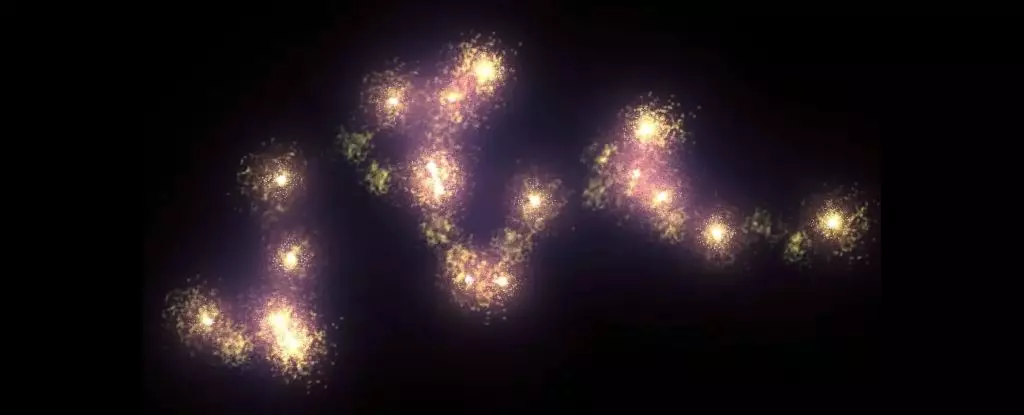Astronomical discoveries continually reshape our understanding of the cosmos, and the latest revelations around the Hercules-Corona Borealis Great Wall are nothing short of revolutionary. Originally suggested to span a staggering 10 billion light-years, new investigations have indicated that this colossal structure might be even more immense, potentially reaching 15 billion light-years. Such a recalibration of this superstructure not only astonishes but also forces us to rethink the existing paradigms of cosmology that underpin our understanding of the universe.
The implications of this finding unfold into a range of complex questions regarding cosmic formations, the distribution of galaxies, and the very fabric of spacetime. A re-examination of gamma-ray bursts, the most energetic explosions known to science, has served as the foundation for this groundbreaking research. Experts in cosmology István Horváth, Jon Hakkila, and Zsolt Bagoly, initially announcing the Great Wall’s existence in 2014, have returned with a more comprehensive analysis that draws upon a dataset encompassing 542 gamma-ray bursts. By scrutinizing these high-energy explosions across the cosmos, the researchers have successfully differentiated between gravitational clustering induced by massive masses and mere statistical anomalies.
Gamma-Ray Bursts: Cosmic Lighthouses
Gamma-ray bursts act as hierarchical beacons illuminating the dark expanses of our universe. Generated from catastrophic events like black hole formations or the violent mergers of neutron stars, these bursts are particularly useful for astronomers because their immense brightness allows them to be detected over unfathomable distances. This property enables scientists to construct a map of galaxy distributions, substantially aiding our understanding of cosmic structures.
The latest research reveals a wealth of information hidden within the gamma-ray bursts, particularly regarding their ‘redshift’—a measurement that indicates how much the wavelength of light has elongated due to the expanding universe. The new observations suggest a truly vast expanse for the Great Wall, from a redshift of 0.33 to 2.43. This not only amounts to a remarkable distance but also propels the Great Wall beyond what traditional cosmological models suggest is feasible.
Cosmic Paradox and Redefining Our Models
These staggering dimensions clash with the principles rooted in our cosmological theories. The cosmological principle posits that, at monumental scales, the universe should be smooth and homogeneous—every region should reflect a similar cosmic landscape. Findings that reveal structures exceeding 1.2 billion light-years seem to defy this notion. Existing entities like Quipu, South Pole Wall, and the Clowes-Campusano large quasar group, each push the envelope further, bringing our universe to the brink of unexpected inconsistencies.
The Great Wall—now escalating in size—introduces a particularly glaring challenge to our underlying models. Is the universe genuinely as homogenous as we once believed, or are we on the precipice of a fundamental shift in our cosmological understanding? The implications are profound; the new evidence of the Great Wall signifies that there are likely additional structures lying beyond our current frameworks, waiting to be unearthed.
A Window into Cosmic Evolution
With the latest observations, humanity has gained not just a glimpse but a potential roadmap to understanding the evolution of the universe itself. The findings compel astronomers to reconsider how such immense structures came into being. Was there a specific mechanism at play during the universe’s formative years that allowed for the creation of these colossal formations?
As researchers delve deeper into these theories, it becomes increasingly clear that the universe is not merely a series of isolated events. Instead, it reflects an intricate tapestry interwoven with enormous structures, cosmic explosions, and dark energies whose effects ripple through the very fabric of reality. The potential existence of these massive formations—structures we hardly understand—presents new avenues of inquiry that could unravel mysteries from the Big Bang to dark matter and energy.
Peering into the Unknown
Ultimately, the Hercules-Corona Borealis Great Wall is not just a scientific curiosity; it represents a paradigm shift waiting to happen. Each gamma-ray burst scrutinized hones our perception of the cosmos. As we inch closer to discovering the universe’s depths, it becomes evident that patience and innovation will play crucial roles in untangling these cosmic enigmas.
Every new discovery reinforces our understanding that within the vast expanse of space lies a multitude of unanswered questions. There’s a profound sense of anticipation regarding what lies ahead—as we explore these cosmic giants and their implications, we are, without a doubt, unraveling the storyline of the universe piece by piece. Humanity’s quest to grasp the unfathomable depths of the cosmos continues, lending itself to a future ripe with potential and uncharted wonders.

